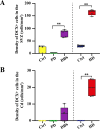Adult Neurogenesis in the Subventricular Zone of Patients with Huntington's and Parkinson's Diseases and following Long-Term Treatment with Deep Brain Stimulation
- PMID: 39829080
- PMCID: PMC12010058
- DOI: 10.1002/ana.27181
Adult Neurogenesis in the Subventricular Zone of Patients with Huntington's and Parkinson's Diseases and following Long-Term Treatment with Deep Brain Stimulation
Abstract
Objective: Parkinson's and Huntington's diseases are characterized by progressive neuronal loss. Previous studies using human postmortem tissues have shown the impact of neurodegenerative disorders on adult neurogenesis. The extent to which adult neural stem cells are activated in the subventricular zone and whether therapeutic treatments such as deep brain stimulation promote adult neurogenesis remains unclear. The goal of the present study is to assess adult neural stem cells activation and neurogenesis in the subventricular zone of patients with Huntington's and Parkinson's diseases who were treated or not by deep brain stimulation.
Methods: Postmortem brain samples from Huntington's and Parkinson's disease patients who had received or not long-term deep brain stimulation of the subthalamic nucleus were used.
Results: Our results indicate a significant increase in the thickness of the subventricular zone and in the density of proliferating cells and activated stem cells in the brain of Huntington's disease subjects and Parkinson's disease patients treated with deep brain stimulation. We also observed an increase in the density of immature neurons in the brain of these patients.
Interpretation: Overall, our data indicate that long-term deep brain stimulation of the subthalamic nucleus promotes cell proliferation and neurogenesis in the subventricular zone that are reduced in Parkinson's disease. Taken together, our results also provide a detailed characterization of the cellular composition of the adult human subventricular zone and caudate nucleus in normal condition and in Parkinson's and Huntington's diseases and demonstrate the plasticity of these regions in response to neurodegeneration. ANN NEUROL 2025;97:894-906.
© 2025 The Author(s). Annals of Neurology published by Wiley Periodicals LLC on behalf of American Neurological Association.
Conflict of interest statement
Nothing to report.
Figures




Comment in
-
Neurogenesis altered by disease and stimulation.Nat Rev Neurol. 2025 Mar;21(3):125. doi: 10.1038/s41582-025-01068-9. Nat Rev Neurol. 2025. PMID: 39962295 No abstract available.
References
-
- Marymonchyk A, Malvaut S, Saghatelyan A. In vivo live imaging of postnatal neural stem cells. Development 2021;148:1–13. - PubMed
MeSH terms
Grants and funding
LinkOut - more resources
Full Text Sources
Medical

